
Have you ever had Bubbies? It’s the brand against which all other pickles are judged, at least in our house! My hubby is a huge fan. And if you like garlic, you’ll probably appreciate Bubbies, too. They’re not made with vinegar, but rather are made the old-fashioned way, though lacto-fermentation in brine. (I have a Bubbie’s Bread & Butter Chips pickle recipe too, which is made with vinegar.)
So for my very first attempt at homemade pickles, I turned the Bubbies jar upside down, identified which spices were in there, selected what looked like a good lacto-fermented pickle recipe, and hoped for the best as I sacrificed a couple of humongous garden cucumbers for the Great Pickle Experiment.
The results were shocking…in that I was shocked I had made something so tasty and convincing on the very first try. I certainly had expected the worst. In fact, I thought Hubby was being sarcastic when he tried the first one and told me they were awesome. He couldn’t stop talking about them! I was skeptical until I tried one, too. YO! Later, I did a taste test of my pickles compared to Bubbies; I actually liked mine even better! In the photo above, I used my large garden cucumbers, but to get the true Bubbies experience, go for the really small cukes; I find these at the farmer’s market, or at ethnic grocery stores. Go for organic if you can (which would be an upgrade from Bubbies, since theirs aren’t organic). Of course the really big cucumbers are fine to use, but because of their size, their insides won’t be quite as firm and crunchy as a smaller cucumber would be, and their skin will be a little tougher.
*****
Lindsey’s Bubbies Pickle Recipe:
1 gallon glass jar or ceramic crock
1/2 a gallon of warm water (tap water is fine)
A handful of fresh, clean grape leaves, oak leaves, or cherry leaves (optional — they supply tannins to keep the pickles crunchy) (UPDATE: raspberry & blackberry leaves work too, but have a stronger flavor than grape leaves)
3-4 lbs of cucumbers (small to medium is ideal, but if all you have is large, cut them into spears)
5-6 Tbsp non-iodized sea salt. I use Redmond RealSalt brand unrefined sea salt. (I usually prefer 6 Tbsp. Using 5 Tbsp of salt will yield a less salty pickle that my hubby prefers, however you may have to contend with more white film, or “kahm yeast,” on the surface of the brine during fermentation. More about kahm yeast in the instructions.)
2 – 3 heads of garlic, separated into cloves, peeled, & roughly chopped
3 Tbsp whole dill seed
2 Tbsp whole coriander seed
1 tsp whole mustard seed (brown or yellow, doesn’t matter)
1 tsp whole peppercorns
1 tsp fennel seed
1/2 tsp red pepper flakes
*****
Ingredients for Homemade Bubbies Pickles. My homegrown garlic was a little small, so I used 4 heads.
*****
Directions:
Rinse the cucumbers, making sure the blossoms are removed. Soak them in very cold water for a couple hours (if they’re not straight off the vine).
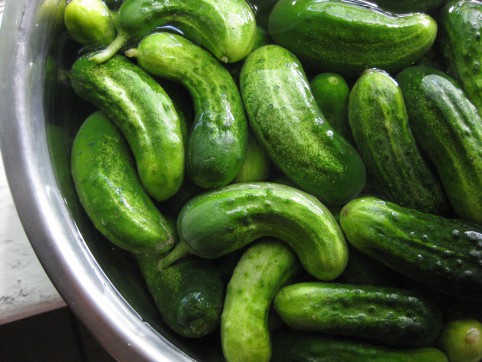
In a separate clean jar (not the one you’ll be using for the pickles), dissolve the salt into the 1/2 gallon of warm water. Set aside — this brine will be one of the last things you’ll add.
Into the clean, gallon jar/crock you’ll be using for the pickles, drop in the garlic, dill, coriander, mustard, peppercorns, fennel, and red pepper flakes.
Then, put the cucumbers into the jar. If you’ve sliced large cucumbers into spears, pack the spears vertically into the jar.

Pour the salt water solution (a.k.a. the brine) over the cucumbers.
Now, place the cleaned grape/oak/cherry/raspberry/blackberry leaves into the jar. My jar has a somewhat narrow mouth, so the grape leaves form a nice plug at the top of the jar so the cucumbers (which will rise to the top after you pack them in) don’t go above the brine.


You want your cucumbers (and leaves) to be completely submerged in the brine at all times. If they’re sticking up above the brine, they’ll get moldy. If your jar has a wide mouth, you may need to use a couple of plates to keep everything submerged. Another idea is to nest a smaller glass jar into the opening of the larger jar to keep everything down. Or, use a scrubbed & sterilized rock.
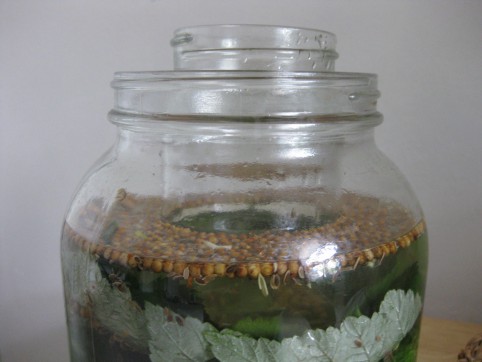
Using nested jars to keep everything submerged.
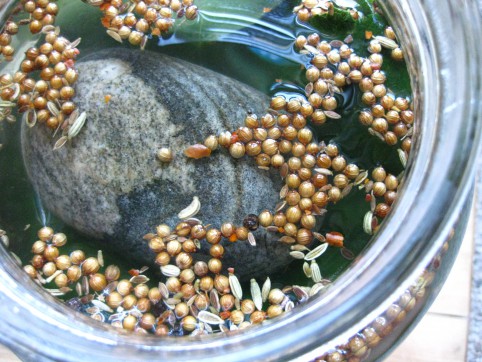
Another idea: use a rock to keep everything submerged.
If the brine still doesn’t cover the cucumbers, make more brine solution using: 1 scant Tbsp sea salt to one cup of water. Cover your jar with its lid (loosely), or with a cloth to keep bugs & dust out. If you see a thin film of white scum growing on the surface of the water, just skim it off as often as you can, but don’t worry if you can’t get it all. This is “kahm yeast;” it won’t harm anything, but do try to keep up with it otherwise it can affect the flavor of your pickles.
Sometimes, during pickle making, some of your garlic cloves will turn blue. This is not a problem. The Colorado Extension Service website says this about blue garlic:
Blue, purple or blue-green garlic may result from immature garlic or garlic that is not fully dry, from copper pans, or from a high amount of copper in the water. Garlic contains anthocyanin, a water-soluble pigment that under acid conditions may turn blue or purple. A blue-green color also may develop in pickles made with stored red-skinned garlic. Except for blue-green color resulting from an abnormally high copper-sulfate concentration, such color changes do not indicate the presence of harmful substances.
Your pickles will be ready after 1-4 weeks — depending on the temperature in your house. Our pickles are usually ready after 10 days on the counter in our warm apartment (average of 80-85°F) in late summer. Every couple days, do a taste test of your pickles. They’re ready when they taste done to you! Once they taste done, transfer the jar into the fridge to slow fermentation. Once they’ve fermented and are in the fridge, you can remove the grape/oak/cherry/raspberry/blackberry leaves and you don’t need to worry as much about the pickles being completely submerged in the brine.
Enjoy! These will last months and months in your fridge. I once kept a batch around for 9 months and it was still good.
And the brine is good stuff too; I like to drink it straight. It’s full of beneficial bacteria and good for your digestion! Since it’s salty, it would be especially good after a workout.
*****
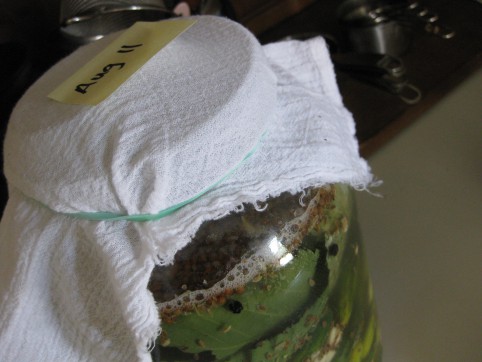












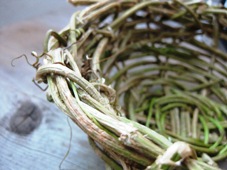



















Nay leaves do contain tannins and use at the rate of 2 to 4 per quart. The tannins add to the crunchiness of the pick. If you dont mund foregoing that extra crunch as in a new pickle then leaving out the leaves will be fine. As a poster above did, can also use 1/8 cup of Black Tea leaves for the tannin boost. Grape leaves are often sold in Middle Eastern markets. Or buy a plant and nurture if you can
My grocer stopped selling bubbies during the pandemic. I found your recipe while looking for places to purchase. In desperation, I tried your recipe. I’ve never tried anything like this before. They came out great. I like them better than Bubbies. I followed your recipe to the T, except I added about 2T of bubbies brine. I used an old ceramic water jug for a crock and found that it’s mouth was too wide. I couldn’t keep everything submerged. I ordered a glass one from Amazon and transferred everything 4 days into fermenting. No problem, still came out great. I can’t wait til the cukes are in at the farmers mark. et.I can’t thank you enough for posting this. It was the one bright side of pandemic for me.
My grocer stopped selling Bubbies during the pandemic. I found your recipe online while looking for stores to purchase from. So I gave it a try. I followed your recipe to a T, except I added about 3 Tablespoon of bubbies brine. They came out great. I like them better than bubbies. I can’t wait for cukes to come into the farmers market. I can’t thank you enough for posting this recipe. It was the one good thing that came from pandemic for me.
I used an organic oolong black tea in a bag and they came out nice and crunchy. I let mine sit submerged in this brine in my crock pot on the counter 5 days with a cheese cloth on it and checked them daily. Then I transferred them to sterile jars added another teabag to each jar and put them in the fridge. They are awesome.
Can I use Bakl pickle crunch instead of grape leaves? I can only find dried or brined grape leaves on line.
Made your recipe 4 days ago. Covered the jars with cheese cloth and a rubber band. Yesterday(day 3) I noticed little bubbles on the top of each jar. Does not look like mold. Should I be concerned or is it the fermenting process at work. I feel like I’m conducting a science experiment. Thanks for posting this recipe. I love Bubbies and I hope I love these too!
I LOVE Bubbies pickles, although I don’t care for the $12 price tag per jar here in Canada. Decided to make my own and found this recipe. I made a few adjustments- I cut back on the salt- I prepared a gallon of water and 8 tablespoons salt total, to be split between 2 jars. I had leftover brine but no big deal, the salinity was where I wanted it to be.I also used Raspberry leaves instead of grape. I saved 2 cups of Bubbies pickle juice, and added a cup to each Jar.I fermneted 7 days and cannot express how pleased I am with the results. I actually can’t believe I made these pickles, they’re fantastic! Salinity is well balanced, nice garlic punch, perfectly sour and a great crunch. I will always save the brine from each batch, and add a cup to the water/salt mixture for each new Jar as a “starter”. Thank-you for this recipe, I will be making these forever.
Chris I am SO happy for the success you had. What a great feeling. Thank you for reporting back here! Cheers!
Marchell, I’m not sure. Fine to leave out the leaves — I think I’d do that if you can’t find them.
Ahhhh! Pamela, thanks for reporting back on the use of a teabag for tannins. Very interesting. Sounds like it didn’t affect the flavor much. I’m so glad you had success! Also a great idea to use your crock pot as the fermtentation vessel. Smart!!!!
Thanks again for reporting on the tea bag.
Kathleen I’m so happy for your success with the pickles. What a great feeling. Thanks for reporting about your success and your alternation to the recipe. Thank you for commenting!!
Sue I’m sorry but I’m not sure. I’d need to test that. If you do/did add it, report back and let us know your results.
Philip I have never tried with okra — if you do, report back and let us know how it went.!
Bill,
Thank you so much for your comment and I agree about mostly everything I ferment — after sitting in the fridge for months it ages into something with even better taste and somehow more complex and mellow at the same time. I’m so glad you decided to try the pickle recipe and that it worked for you. I love drinking the leftover brine, and you’re right the pickled garlic is great too.
Cheers!
Leilani,
Sorry for the delay in responding but hopefully you were able to find a pepper to put into the brine. No extra steps, just buy the type of hot pepper you prefer and add it in with the cucumbers.
Joshua,
Gosh I have no idea about the bubbles. Scrape off the kahm as it forms to keep it from altering the taste of the pickles, but I bet the bubbles are OK.
Sara – YES! It’ll all work out fine.
A couple bay leaves would taste good, but as far as using them to replace the grape leaves, ehh, I’d just leave em out. Some folks have used a tea bag (black tea) with good results (for the tannins).
I found your recipe about 3 years ago, tried it, and found them to be better than Bubbie’s. Last year I pickled 100 lbs. of cukes using this recipe. I also tried canning them (which I didn’t know was possible until I found an article online), which worked great. The pickles taste as good as the refrigerated ones, and are just as firm and crunchy, and this makes it possible to have them year-round and frees up refrigerator space. This year I plan to pickle 150 lbs., and if there is still time in the cuke season, maybe 225 lbs. (I can do 75 lbs. per batch). Everyone who has tried them loves them, so they’re in high demand. I plan to give away lots to my pickle-loving friends. Thank you – you’ve given me a new hobby (passion?).
I forgot to mention – one addition I made is to add some red peppers to add a little zing. I use the small Japanese peppers packaged in the grocery store. In 2021 I made some both ways, with and without the peppers. Last year I made them all with peppers because nearly everyone prefers the spicier ones with peppers. They’re all bit less hot than the hot Bubbie’s pickles, and I love them.